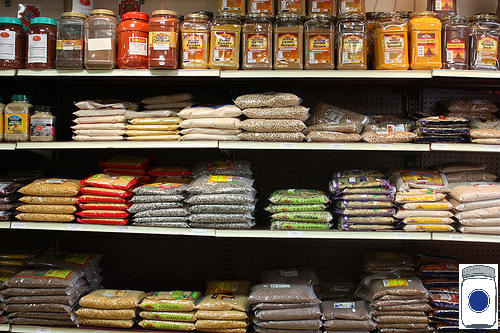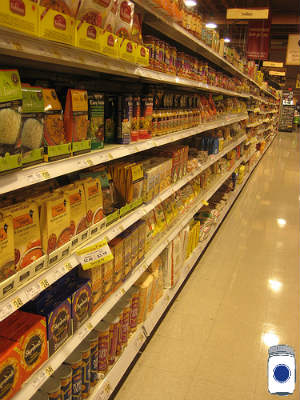The Indian Grocery Store
How to Make Indian Recipe Substitutions (& still have it taste like Indian food)

My love for travel and my love for food are perfectly paired on a quiet afternoon when I can indulge myself with a trip to a local ethnic food market. I have done this ever since I have had a driver’s license, and I was traveling overseas by myself even before that. The quest for that aroma or that tea flavor draws me through ethnic food markets almost like the cartoonish waft that would carry a Loony Toons character to the pie on the windowsill, but the prize to me is an instant transport to a memory. Sometimes, it isn’t to a former moment in history, but instead a new skill, a new food, a new fact I learn along the way.
Take the Indian Food Market, for instance. I have never gone to India, though I have many wonderful memories of sharing the rich homemade foods in a friend’s home; and I hold some memories of Indian foods in places like Africa. Most often, I find that the reward for me in Indian food stores is the great deal on bulk ingredients (especially on things like rice, nuts, oils, and legumes), or discovering a new cookie, or learning how to open a cardamom seed pod by the retail clerk behind the counter.

Some cooks shy away from Indian recipes because so many books are written in the metric system, something that make many of us Americans feel incompetent (speaking for myself here). Others shy away because the ingredients list alone contains ingredient names that seem so exotic and out-of-reach. Believe it or not, many of those are things that you already have on your shelf…a chickpea by any other name tastes just as sweet, I promise.
Indian Food is generally whole food (notwithstanding the trend towards the boxed convenience versions). Fermentation, whole grains, and rich spices play the leading roles in every dish. Let’s take a look at the flours you might find in your recipes and a few suggestions for using the whole ingredients you have on hand:
Atta Flour or Chapati Flour
Chapati is a roasted bread that does not have a leavener in it traditionally. It is the dough resting time and heat of the griddle slathered in ghee that give it a slight rise. Recipes that call for either Atta Flour or Chapati flour will require a low gluten flour to allow it that natural rise. If using the wheat berries you have on hand, use soft white. I suggest using your sifter and then saving that beautiful germ for tomorrow’s breakfast yogurt.
Ladu Flour
Coursely grind soft white, spelt flour, or chickpeas—or any combination of these– as this is typically used for an item similar to a doughnut, called a “Ladu” or “Ladoo”. You will want a wheat flavor that pairs well with the sweetness of ghee and sugar.
Halim or Lapsi
Use your hand crank grain mill to coarsely grind any grain you prefer, preferably hard red or hard white wheat. This is going to be a hearty base for stews and pilafs. Lapsi is generally the term for a cracked wheat and sometimes comes finer for dishes like a salad (think Tabbouli).
Semolina
You might recognize that word from the store-bought pasta. Semolina is sifted durum wheat, and is extremely starchy and usually bland in flavor. I personally do not believe in sifting flour unless I am using the sifted portions in other dishes so that we still get the full nutritional balance as God intended. Indian foods that call for Semolina might be either sweet or savory, and so you might need to make a judgment here as to which grains would best suit the dish. Millet, rice, and spelt are options. Chickpea is always a wonderful substitution for anything with a sweeter flavor and holds to the true authenticity of Indian cuisine. However, chickpea will not be starchy enough for many things, so you will want to use it as only part of the flour, mixing it with either durum or hard white.
Sevian
This is not a flour. It is a noodle as thin as vermicelli, very difficult for the home cook to achieve even with the best of pasta makers. That means that you will have to make a judgment call here; either make your homemade noodle work and know that it is not quite authentic, or take a chance that you will feel sluggish in the morning from eating a processed noodle. For me, I am fully aware that my version of Indian cooking is not authentic, but delicious just the same, and nourishing. If you make your own noodles, use either durum or soft white for sevian, and strive to make them as thin as possible.
Maida or Maitha Flour
Read: Bleached, Enriched, All Purpose. So for all of you whole-foods cooks reading this, you are not new to this frustration. This is often used in pastry or “quick bread” style of cooking, so in those cases definitely use soft white flour (perhaps with some chickpea thrown in for good measure). When flatbreads call for this, you have more options. Consider spelt or hard white along with the soft white or chickpea flours you might be using.

LEGUMES
Chickpea = Gram = Chana = Patani = Bengal Gram = Maghaj = Garbanzo Bean Flour
Did you catch all that? The names may be derived either from the brand of chickpea or a regionally preferred name for the same thing. No matter, it is deliciously sweet but low in gluten. You will want to keep it around 25-35% of the flour if you need a flour with a higher gluten. It is absolutely addictive in a myriad of Indian cookies and desserts. It is perfect for a thickening agent and for batter (we use this for non-Indian dishes, too). You can use this to thicken a too-spicy curry to soften the final bite, to make dumplings, snacks, breads, desserts, or breakfast. Get really creative with this ingredient!
Not all of the above names are the same in texture or style. For instance, the Maghaj is coarsely ground. Now, it can start to get confusing, because chickpea is such an extremely common flour that each flour blend has its own name:
Dokla—chickpea with rice flour
Ondhwa—chickpea, rice, and black lentil
Dakor Gota– chickpea and wheat flour, usually blended with spices to make fritters
Bajri—chickpea and millet
Raji—chickpea and red millet
Matha Flour
Do not confuse this with Maitha flour, mentioned above. This is a legume (moth dal) which are apparently similar to mung beans. If you know of any easy substitutions we can readily make in a well-stocked pantry, please leave a comment below and we will add it to the list!
Moong Flour
This is also made from mung beans, but have a different (finer) texture because they are skinless and have been split.
Other Flours
Mutter Besan, not Besan (which is chickpea), is from yellow split peas. Urad is from skinless black lentils, and Rajagro is really Amaranth. Many home cooks using bulk ingredients can easily substitute the lentils and split peas on hand. Your colors, textures, and flavors may vary—but the nutrition and wholesomeness of the food will nourish your family. You will find that you can make very affordable and exotic dishes to wow your family and friends.
Last Thought
A tip about the stores: the clerks are usually very helpful. I visited my local Indian store weekly and the clerk waited for me and knew me by name—because I routinely asked him to explain to me how to cook something I have never made before. He did not hide his pleasure as he walked me through the store, discussing his passion for the food of his culture. I highly recommend you do the same. The labels are generally written in English along with their languages, so do not worry that the list of various flours or ingredients is long—you can often discover these things just by reading the package!
Above all, this is a wonderful time to pull out your grain mill and experiment with various grains and legumes you already have in your cupboard, to discover all of the culinary potential these whole foods possess. There is more to do with split peas than soup, more to do with chickpeas than hummus.
Do you want to share your favorite ethnic food store bargain or give us a tip on how to make ethnic recipe substitutions? Please leave a comment below.
Further Reading:
Bladholm, L. (2000). The indian grocery store demystified. Los Angeles: Renaissance.
Signh, R. (1994). The wonderful world of Indian cookery. Gretna: Pelican Publishing Company.
Photos:
Awami Markaz, a Texas Indian Food store found: http://www.buysellitems.com/store.php?s=awamimarkaz&p=191
Svadilfari via photopin cc
emma_brown via photopin cc

many store are provides wholesale products, they gives a chance to save your money. this is very good service and indian foods are always in demand..!